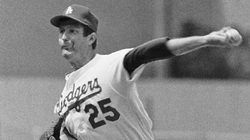
From that perspective, you can say that Tommy John surgery (surgery to repair a UCL tear), surgery to repair a torn anterior capsule muscle and rotator cuff surgery have saved many a pitcher's baseball career. But: does that mean each and every MLB pitcher that has an operation like this could absolutely not pitch through it? Has every operation absolutely been necessary? The answer is probably no, but it is pointless to go through each and every operation and try to decipher which ones are necessary and which ones can be pitched through. But I am sure there are some that may have not been necessary.
What we know is this: Arm injuries have been around since the beginning of baseball. It is not natural for a human being to throw a baseball an exorbitant amount of times for a considerable amount of years and have no structural damage to the shoulder or elbow. These things have always happened. The difference is due to the MRI, doctors are able to see with their own eyes whether there is structural damage to an arm and exactly how severe it is. Once something is diagnosed, the next step is to do something about and that "something" is seldom just rest and rehab. So those who think these arm injuries are new, the fact is these injuries have been around for years, possibly since the inception of baseball. The difference is that doctors now can see with their own eyes the damage to the muscles, tendons and bones in a pitcher's arm. Because of this, the option pitchers used to have to pitch through an injury like this does not exist. That is what has become obsolete.
What does not make sense is how many do not understand basics in preventing arm injuries. I am no doctor, but when a 10-12 year old kid is throwing a curve ball odds are it will mess their arm/ elbow/ shoulder up sooner rather than later. But lets be honest, parents of gifted athletes care as little about their kid's well being than the coaches. The father of the kid gets to relive his youth through his son. His son is the guinea pig. Coaches, even down at the Little League level, will do anything to win. This goes through high school, college and every baseball league they pitch in until they reach the professional level.
Part of the problem is the fact that Tommy John has become extremely popular because pitchers are, in some cases, coming back stronger and have more success after the surgery than they did before it. That leads many to think the operation is an enhancement and will always work out to make the pitcher better. What a lot of people do not realize is the fact that the surgery is not a 100% science. In fact, it is far from that. I would bet that those that have the operation without it being completely necessary have less of a chance to become a better pitcher with it being done. However, I do not have the numbers to back it up though.
The million dollar question is what can be done to prevent these type of injuries? The answer is nothing as they will happen regardless of what is done. But I feel very strongly that plenty of things can be done to reduce the amount of these operations. There are silly suggestions like offer a bonus to a player or organization if they make it through a period of time without a TJ operation or give a pitcher an option to not have an MRI if they feel elbow pain. All kidding aside, how is it that a coach in Little League, in Babe Ruth League, American Legion, High School or College can pitch somebody excessively just to win games? I understand rules have been put in place to make it better in LL and lower leagues. But what about High School and College? It is pretty evident that pitchers are abused at every level before they become pro.
Pitch counts should be mandatory. Or should they? Pitchers are throwing unlimited pitches in HS and College and all of the sudden, they are on a limit. That makes no sense. A pitcher who is used to throwing 120 pitches in HS and College all the sudden sees his workload diminish. That could lead to some arm injuries. How about the old time pitchers? Guys like Tom Seaver, Steve Carlton and Nolan Ryan threw unbelievable amounts of pitches at all levels and did fine. Perhaps the knowledgeable ones in the game are putting too much emphasis in the pitch count. A guy who has never thrown more than 100 pitches in a game may in turn never be able to throw 100 pitches in a game. When the young stud is pitching in a pennant race, the manager may push him. But contrary to the older pitchers who have done this their entire life, the pitcher is in uncharted water. Even if they were abused in HS or College, they still went 3-4-5 years without throwing that many pitches in a game. And all the sudden, they are expected to "ease" into it. Masohiro Tanaka threw over 120 pitches in a complete game last season, then closed the NEXT GAME. He seems to be doing fine now.
Getting a chance to speak with former MLB catcher Gregg Zaun a couple months back, he told me the real reason he stopped playing after 16 MLB seasons and 21 professionally. It turns out it had little to do the wear and tear on his knees, but more to do with the change in the actions of the young pitcher. Zaun's uncle was Rick Dempsey. Dempsey played 24 seasons in MLB and either Dempsey or Zaun were playing baseball professionally from 1967-2010. Zaun says there has been a complete change in the attitude of the young pitcher. They seldom follow the simplest set of instructions and simply want to do things their own way. Few pitch to location... they just rare back and fire. Little is done now a days to teach a pitcher to throw to spots. That effects arm angles and pitchers have a difficult time repeating their motion. Whether the proof is there or not, I bet there would be less arm injuries if pitchers learned to pitch to spots in the minors. It certainly helps to be able to repeat a motion consistently and have an idea where the ball is going.
And lets be honest, the stud young pitcher is calling his own shots, for the most part. Of course, Stephen Strasburg could not tell the Nationals not to shut him down during the season they made it to the playoffs. But Tim Lincecum comes into the game and says he is going to listen to nobody but his dad. A veteran coach or catcher in the minors has nothing on the pitcher who has already been paid and is the future of the organization. If there is a dispute, the coach is getting fired and the catcher released before anything is said to the pitcher. You have a group of young, unproven rich pitchers who are dictating what they should do and throw and it never used to be that way. I feel they are leading themselves to injuries simply because they do what they want.
Another point was brought up when I spoke to Denny McLain. He was one who certainly benefited from the mound prior to it being lowered after the 1968 season. He went 31-6 in 1968 and is the last pitcher to ever win 30 games. However, he suffered from arm problems and was finished pitching in the majors by 1972. He puts a lot of the blame on the mound being lowered and feels if it were raised, there would be less arm injuries. Baseball would be against it as they feel the mound being lowered increased the offensive production and took a distinct advantage away from the pitchers. Perhaps more should look into the strain of a pitcher throwing from a more flat surface as opposed to a higher mound.
In all honesty, there is no true formula to saving pitchers from this sad stage of TJ surgeries. But with a little attention put to a couple of different things, I am sure the amount can be reduced.

 RSS Feed
RSS Feed
